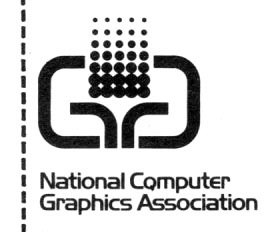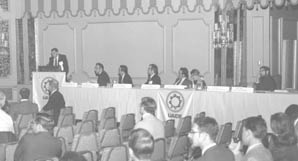Chapter 7: Organizations, conferences, & graphics standards
7.1 CG Organizations and Conferences


The IEEE Computer Society is the world’s leading organization of computer professionals. Founded in 1946, it is the largest of the 37 societies of the Institute of Electrical and Electronics Engineers (IEEE) with nearly 100,000 members.

In 1947, members of the computing community founded a professional organization called the Association for Computing Machinery (ACM), to provide professional and educational opportunities for its members. It has grown to approximately 75,000 members from every area of the computing related field.
The American Federation of Information Processing Societies (AFIPS) was established on May 10, 1961, to advance and disseminate knowledge in the field of information science, and to represent member societies on an international level. The federation was an outgrowth of the National Joint Computer Committee, which was established in 1951 to sponsor the Joint Computer Conferences. The founding societies of AFIPS were the Association for Computing Machinery (ACM), the American Institute of Electrical Engineers, and the Institute of Radio Engineers (the latter two eventually merged into the IEEE, or Institute of Electrical and Electronic Engineers). One of the main contributions of AFIPS was its sponsorship of the Joint Computer Conference, renamed the National Computer Conference in October 1973. These semi-annual conferences featured technical sessions and exhibits relating to the field of information processing. They were discontinued after 1987 because of the financial condition of the organization
One of the unique components of the ACM organization is the Special Interest Group, or SIG (in the early days they were called Special Interest Committees, or SICs). The individual computing specialty areas are represented in one of these 35 SIGs. Like the umbrella ACM organization, each SIG is governed by a board made up of volunteer members.
In 1967, one of the ACM Board members was Sam Matsa, who started his career as part of the IBM/GM relationship that would result in DAC-1 and the IBM 2250 display. Matsa and Andy Van Dam of Brown University organized a professional development seminar in graphics as part of a larger series of seminars. Matsa convinced ACM to sponsor these seminars, which traveled around the country, attracting 40 or 50 people to each. In the graphics seminar, Van Dam taught the hardware side and Matsa taught the software component.

As a result of the interest in the graphics discipline, evidenced by the attendance at these seminars, Matsa and Van Dam convinced ACM that they should recognize a Special Interest Committee in Graphics, and SICGRAPH was born. Matsa was the founding Chairman and Van Dam as Secretary organized the SIC newsletters.
In 1969, the members wanted recognition of the area in the way other computing disciplines were recognized, with elected rather than appointed officers, so a lobbying effort resulted in enough signatures to convince ACM to give the SIC a Special Interest Group designation, and ACM-SIGGRAPH was established. Its first elected chair was Ed Devine. Jon Meads named it SIGGRAPH: the Special Interest Group on Computer Graphics and Interactive Techniques in the bylaws, in order to recognize the graphics and the human interaction parts of the equation.
The organization participated in the broader ACM conferences, and published a quarterly newsletter. Interest ran the gamut from simulation and modeling, to text editing and composition, to computer generated art, cartography and mapping, computer aided design and, computer graphics software and hardware.

In 1973, Meads and Bob Schiffman organized the first annual SIGGRAPH conference, which has become one of the compelling aspects of the organization. It was held in Boulder, Colorado in the summer of 1974 as the 1st Annual Conference on Computer Graphics and Interactive Techniques. Attendance was approximately 600 people. There were no formal proceedings published, rather the papers were included in an obscure journal from Pergammon Press. The next two conferences, at Bowling Green, Ohio and Philadelphia, were only moderately successful. In 1977 the conference was held in a Hyatt in San Jose, and it was a resounding success, leading to decades of successful and important SIGGRAPH conferences. The Proceedings of the Conference remains an accepted scholarly journal for the publication of technical contributions.
Tom DeFanti, who graduated from Ohio State and later served as SIGGRAPH Chair, organized film and video presentations in the early conferences, and in 1979 started publishing them as the SIGGRAPH Video Review. These sessions are now called the Electronic Theatre, part of the Computer Animation Festival, a juried conference event. In 1995, Frank Foster arranged to have this evening of visuals in a formal theatre setting, away from the conference venue, at the famous Shrine Auditorium in LA.
Over the years, Panels and Courses were added, an Art Show became a mainstay, and venues for emerging technologies were provided. Several related conferences have occasionally co-located with SIGGRAPH, and an Education track became part of the overall conference offerings.
The above section is based in part on an article in the SIGGRAPH newsletter by Carl Machover. http://www.siggraph.org/

The National Computer Graphics Association (NCGA) was founded in 1979 by Joel Orr and Peter Preuss. It evolved from the standardization efforts of SIGGRAPH, and some frustration that the industry was not necessarily being served well by a single entity in the form of SIGGRAPH. It held its first conference in Virginia in 1980, with an expanded equipment exhibition, workshops and tutorials for attendees, and an award program for images and videos (SIGGRAPH chose not to pick any “best of…” until 2003.) For many years, it was important for graphics professionals to attend both conferences, but during the downturn in the 90s, NCGA fell on financial hard times, and is now defunct. Several subgroups of NCGA, such as the CAD Society have survived. It is an occasional informal gathering of professionals–vendors, consultants, and users–who are interested in CAD.

In 1980, the European Computer Graphics Organization, Eurographics was formed. They held their first conference in Geneva that year. There were also organizations in Australia (Ausgraph), Canada, the Netherlands (ISEA – The Inter-Society for the Electronic Arts ), Japan (Nicograph’s first conference was held in 1982) and elsewhere. The CGS (Computer Graphics Society) was formally founded in Geneva in 1992. Also, beginning in 1962 the Users of Automatic Information Display Equipment (UAIDE) annual conference was the home for leading edge computer graphics papers until SIGGRAPH came along. During the mid-1980s, Pratt Institute in New York sponsored an annual conference (ComGraf), and there were conferences in Paris (Parigraph), London (ComputerFX), MonteCarlo (Festival International de Television de Monte Carlo), Canada (Graphics Interface), and many other locations in the U.S. and abroad. Besides SIGGRAPH and NCGA, a big conference for CAD professionals was the Design Automation Conference. (See Machover’s UAIDE discussion in the May 2000 SIGGRAPH newsletter).
Eurographics was formally founded in spring 1980. Under the chairmanship of José Encarnação, it was given its first operational structure, composed of an Executive Committee, an Executive Board, a Workshops and Books Board, a Professional Board and a Conference Board.
Two years later, the British Chapter was founded. The Computer Graphics Forum started and first contracts were made with ACM-SIGGRAPH (USA), Austrian Computer Graphics Association (A), British Computer Society (UK), Gesellschaft fuer Informatik (D), the J. von Neumann Society (H) and the NCGA (USA). In 1984, now under the chairmanship of Paul ten Hagen, the German Chapter followed. Affiliation agreements between GI (D) and EG, and between SIGRAD (S) and EG were made in 1985.
In 1986 Carlo Vandoni took the lead, and in June, Eurographics was registered at the “Registre du Commerce” in Geneva. The Spanish Chapter was founded 1987, the Portuguese Chapter followed only a year later. Moreover, affiliation agreements with the Austrian Computer Graphics Association (ACGA), the German Computer Society (GI), the Norwegian Computer Graphics Scociety (NORSIGD) and the Swedish Graphics Interest Group (SIGRAD) were made along with liaison agreements with societies in China and Japan.
The years 1987-1988 represented a period of stabilization for the Eurographics Association with respect to the number of individual and institutional members thanks to various promotional activities. Also, the services offered to members improved considerably: student and spouse membership were introduced, the CGF appeared at rather regular intervals and discounts to members for IEEE CG&A and for the Springer series were offered.

More affiliation agreements were made with the French Computer Society (AFCET), the Italian Computer Society (AICA), the Finnish CAD/CAM Association, the Dutch Computer Society (NGI) and with the Swiss Computer Graphics Association (SCGA) and the Nicograph Association in 1989 and 1990 under the chairmanship of Roger Hubbold. Under his lead, the EG conference proceedings were made a special issue of CGH. Furthermore, the official EG logo was created at that time, programmed by hand in PostScript.
At this time, the working groups for Pictures and Multimedia, Computer graphics and AI, Computer graphics Hardware, Scientific Visualization, Relationships Between Image Synthesis and Image Analysis were established.
In 1991, Jürgen Schönhut was elected chairman of the EG Association. The Editor of Computer Graphics Forum changed to NCC Blackwell Publishers and H.P.Seidel was announced its new chief editor. In 1992, David B. Arnold took over as Chair. A new agreement with Springer Verlag to publish the Eurographics Workshops in the new “Focus on Computer Graphics” series was made in 1993. EG started its web presence in 1995 by establishing its website under the lead of Ivan Herman.
In May 1996, on a workshop on the future of Eurographics, the main focus of EG was set as “an association of professionals to help professionals in their careers in computer graphics and interactive digital media”. Under the presidency of W.T.Hewitt, a liaison agreement with the Chinese Computer Graphics association was also signed that year. In the following year, the Eurographics publications catalogue got inaugurated on the website www.eg.org, replacing the printed catalogue.
In 1999, under the lead of Dieter Fellner, the Online Board was instated and the cooperation agreement between Eurographics and SIGGRAPH was renewed. In 2000, due to this cooperation, EG for the first time was operating a stand outside the exhibition area and next to the SIGGRAPH, being a vital sign of EG and showing its standing in the graphics world. In the same year, a cooperation with IEEE TCVG was signed and the digitization of back issues of Computer Graphics Forum started.
The Italian Chapter was founded in 2001 under the presidency of P.Brunet. In 2003 the French Chapter started.
(From History page of the EG website https://www.eg.org/wp/history/)
